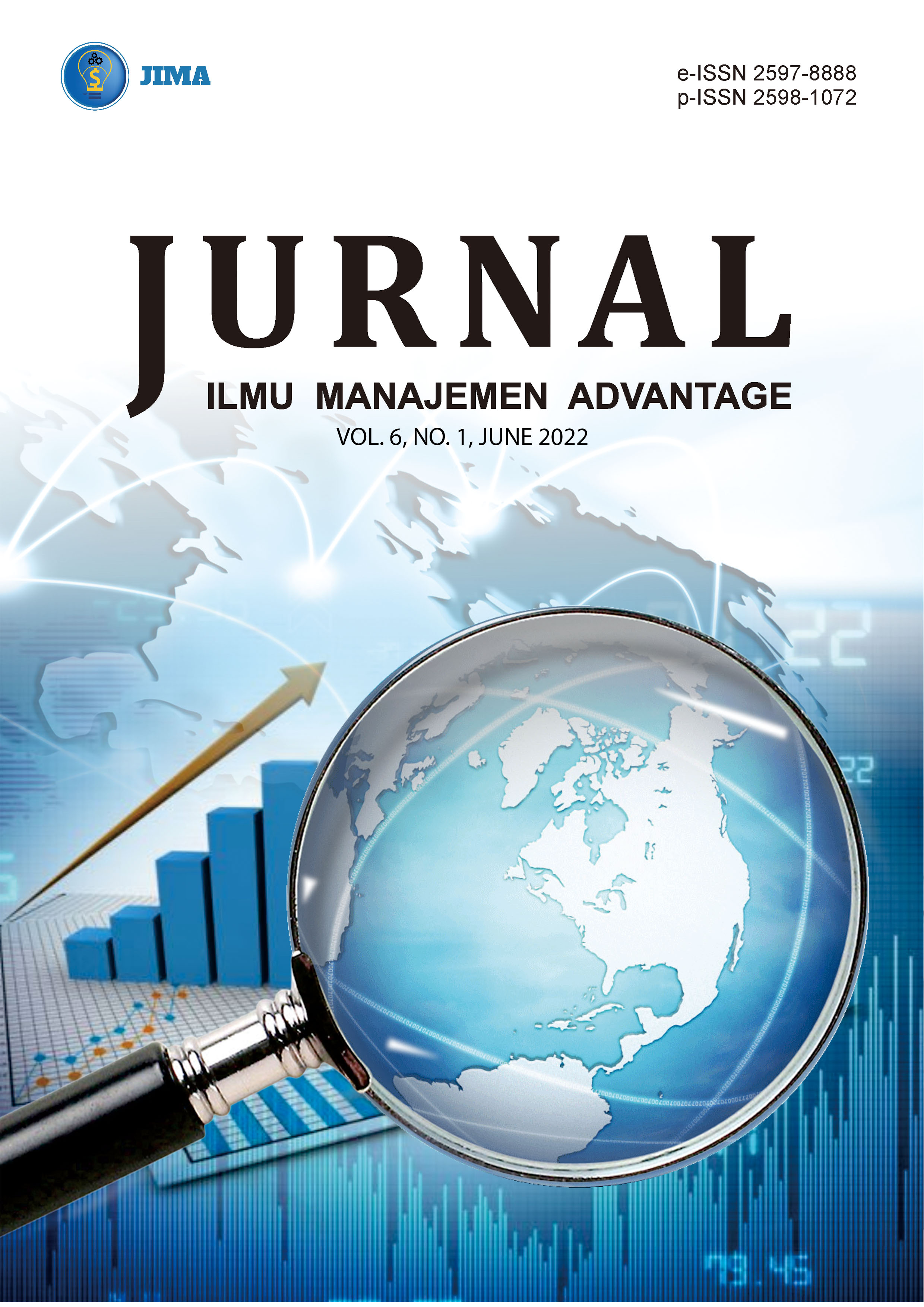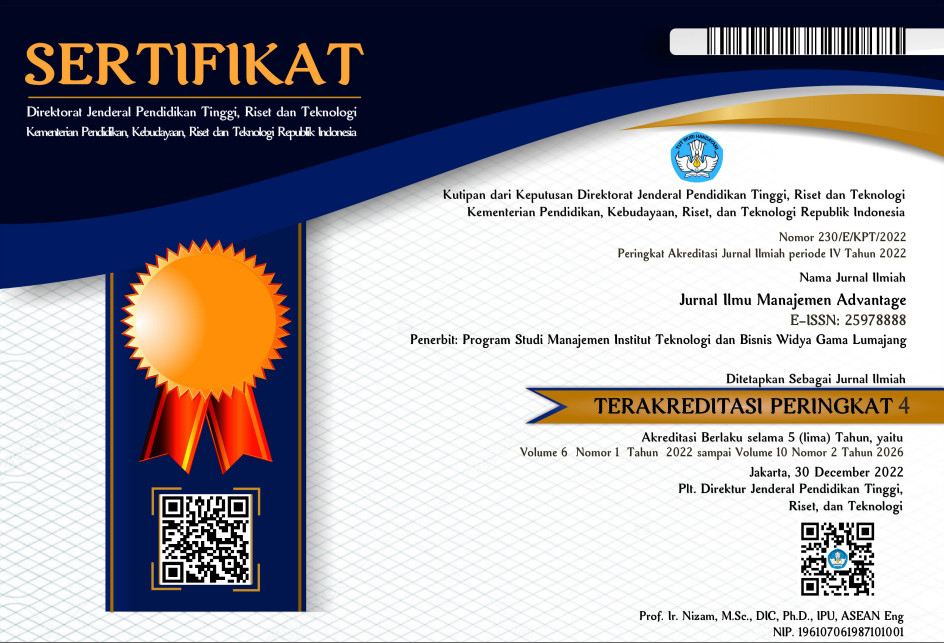Understanding the Driver of Customer Purchase Decision: The Role of Customer Engagement and Brand Attachment
DOI:
https://doi.org/10.30741/adv.v6i1.835Keywords:
Customer Engagement, Brand Attachment, Purchase DecisionAbstract
The purpose of this study is to understand the influence of customer engagement and brand attachment in increasing purchase decision of customers. This study is using quantitative approach, with the population of customers of local make-up brands in Yogyakarta, Indonesia. The total number of samples is 115 respondents, which is selected using purposive sampling method. The data is collected through distributing questionnaire using online platforms, which is then analyzed using descriptive analysis and path analysis. The results indicate that customer engagement has an influence on brand attachment, brand attachment has an influence on purchase decision, and that brand attachment mediates the influence of customer engagement on purchase behavior.
Downloads
References
Alvarez-Milán, A., Felix, R., Rauschnabel, P. A., & Hinsch, C. (2018). Strategic customer engagement marketing: A decision making framework. Journal of Business Research, 92, 61-70.
Barhemmati, N., & Ahmad, A. (2015). Effects of social network marketing (SNM) on consumer purchase behavior through customer engagement. Journal of Advanced Management Science, 3(4), 307-311.
Barreda, A. A., Nusair, K., Wang, Y., Okumus, F., & Bilgihan, A. (2020). The impact of social media activities on brand image and emotional attachment: a case in the travel context. Journal of Hospitality and Tourism Technology, 11(1), 109-135.
Bowden, J. L. (2009). The process of customer engagement: A conceptual framework. Journal of Marketing Theory and Practice, 17(1), 63–74
Brodie, R. J., Ilic, A., Juric, B., & Hollebeek, L. (2013). Consumer engagement in a virtual brand community: An exploratory analysis. Journal of Business Research, 66(1), 105–114.
Chen, Y. T. L. S. C., & Hung, C. S. (2011). The impacts of brand equity, brand attachment, product involvement and repurchase intention on bicycle users. African Journal of Business Management, 5(14), 5910-5919.
Creevey, D., Kidney, E., & Mehta, G. (2019). From dreaming to believing: a review of consumer engagement behaviours with brands’ social media content across the holiday travel process. Journal of Travel & Tourism Marketing, 36(6), 679-691.
Hardiky, Mokhamad Iqbal, Devina Kristanti Nova, Amelia Rahmadewi, and Nanik Kustiningsih. 2021. “Optimalisasi Digital Payment Sebagai Solusi Pembayaran UMKM Roti Kasur.” Jurnal Riset Entrepreneurship 4(1):44–48.
Harrigan, P., Evers, U., Miles, M., & Daly, T. (2017). Customer engagement with tourism social media brands. Tourism management, 59, 597-609.
Hew, J. J., Badaruddin, M. N. B. A., & Moorthy, M. K. (2017). Crafting a smartphone repurchase decision making process: Do brand attachment and gender matter?. Telematics and Informatics, 34(4), 34-56.
Hollebeek, L. (2011). Exploring customer brand engagement: definition and themes. Journal of strategic Marketing, 19(7), 555-573.
Jain, N. K., Kamboj, S., Kumar, V., & Rahman, Z. (2018). Examining consumer-brand relationships on social media platforms. Marketing Intelligence & Planning, 36(1), 63–78.
Kahn, W. A. (1990). Psychological conditions of personal engagement and disengagement at work. Academy of Management Journal, 33(4), 692-724.
Keong, L. K., & Baharun, R. (2017). Integrated model of brand image, brand attachment and behavioral intentions: Review and concept. International Journal of Applied Business and Economic Research, 15(21), 277-285.
Krishnakumar, M. (2018). Future apparel buying intention: mediating effect of past apparel buying behaviour and past apparel buying experience. Global Business Review, 19(3), 737-755.
Kumar, V., & Pansari, A. (2016). Competitive advantage through engagement. Journal of Marketing Research, 53(4), 497–514.
Kustiningsih, Nanik, and Bambang Tjahjadi. 2020. “Mediating Effect of Business Process Performance on Innovation Strategy-Cost Performance Relationship: Case Study of Manufacturing Industry in East Java Province, Indonesia.” International Journal of Business Performance Management 21(3):346–62.
Kustiningsih, Nanik, Nawang Kalbuana, Arif Syafi’ur Rochman, Muhammad Miftah Farid, Agus Surya Bharmawan, Ilya Farida, Siti Mazilatus Sholikha, Deddy Setiawan, and Widi Hidayat. 2020. “STUDY RATIO FINANCIAL OF BANK PERFORMANCE: EVIDENCE FROM INDONESIA.” PalArch’s Journal of Archaeology of Egypt/Egyptology 17(9):6571–6605.
Kwon, K., & Kim, T. (2020). An integrative literature review of employee engagement and innovative behavior: Revisiting the JD-R model. Human Resource Management Review, 30(2), 100704.
Lemon, K. N., & Verhoef, P. C. (2016). Understanding customer experience throughout the customer journey. Journal of Marketing, 80(6), 69-96.
Levy, D. S., & Lee, C. K. C. (2004). The influence of family members on housing purchase decisions. Journal of Property Investment & Finance, 22(4), 320-338.
Li, M. W., Teng, H. Y., & Chen, C. Y. (2020). Unlocking the customer engagement-brand loyalty relationship in tourism social media: The roles of brand attachment and customer trust. Journal of Hospitality and Tourism Management, 44, 184-192.
Malär, L., Krohmer, H., Hoyer, W. D., & Nyffenegger, B. (2011). Emotional brand attachment and brand personality: The relative importance of the actual and the ideal self. Journal of Marketing, 75(4), 35-52.
McEwen, W. (2004), “Why Satisfaction Isn’t Satisfying,” Gallup Management Journal Online (November 11) (available at http://gmj.gallup.com/content/14023/Why-Satisfaction-Isnt-Satisfying.aspx).
Park, C. W., MacInnis, D. J., Priester, J., Eisingerich, A. B., & Iacobucci, D. (2010). Brand attachment and brand attitude strength: Conceptual and empirical differentiation of two critical brand equity drivers. Journal of Marketing, 74(6), 1-17.
Prasad, R. K., & Jha, M. K. (2014). Consumer buying decisions models: A descriptive study. International Journal of Innovation and Applied Studies, 6(3), 335.
Prentice, C. (2013). Attitudinal and behavioral loyalty amongst casino players in Macau. Services Marketing Quarterly, 34(4), 309-321.
Prentice, C., & Loureiro, S. M. C. (2018). Consumer-based approach to customer engagement–The case of luxury brands. Journal of Retailing and Consumer Services, 43, 325-332.
Prentice, C., Han, X. Y., Hua, L. L., & Hu, L. (2019). The influence of identity-driven customer engagement on purchase intention. Journal of Retailing and Consumer Services, 47, 339-347.
Prentice, C., Wang, X., & Lin, X. (2018). An organic approach to customer engagement and loyalty. Journal of Computer Information Systems, 60(4), 326-335.
Puccinelli, N. M., Goodstein, R. C., Grewal, D., Price, R., Raghubir, P., & Stewart, D. (2009). Customer experience management in retailing: understanding the buying process. Journal of Retailing, 85(1), 15-30.
Rosetta Consulting (2014). The economics of engagement (pp. 1–9). Retrieved from http://www.rosetta.com/assets/pdf/The-Economics-of-Engagement.pdf.
Saks, A. M. (2006). Antecedents and consequences of employee engagement. Journal of Managerial Psychology, 21(7), 600–619.
Setyawan, Dwi Ageng, Nurul Ila Sari, Iza Auhaina Kuswindari, Diana Etika Sari, Izza Sakhara, and Nanik Kustiningsih. 2020. “Optimalisasi Media Sosial Terhadap Pemasaran Di Usaha Mikro Kecil Menengah.” Equilibrium: Jurnal Ekonomi-Manajemen-Akuntansi 16(1):37–46.
Shareef, M. A., Kumar, U., & Kumar, V. (2008). Role of different electronic-commerce (EC) quality factors on purchase decision: A developing country perspective. Journal of Electronic Commerce Research, 9(2), 92.
So, K. K. F., King, C., & Sparks, B. (2014). Customer engagement with tourism brands: Scale development and validation. Journal of Hospitality & Tourism Research, 38(3), 304-329.
Taqi, Muhamad, Aam Slamet Rusydiana, Nanik Kustiningsih, and Irman Firmansyah. 2021. “Environmental Accounting: A Scientometric Using Biblioshiny.” International Journal of Energy Economics and Policy 11(3):369–80.
Thomson, M., MacInnis, D. J., & Whan Park, C. (2005). The ties that bind: Measuring the strength of consumers’ emotional attachments to brands. Journal of Consumer Psychology, 15(1), 77-91.
Tjahjadi, Bambang, Noorlailie Soewarno, Hariyati Hariyati, Lina Nasihatun Nafidah, Nanik Kustiningsih, and Viviani Nadyaningrum. 2020. “The Role of Green Innovation between Green Market Orientation and Business Performance: Its Implication for Open Innovation.” Journal of Open Innovation: Technology, Market, and Complexity 6(4):173.
Wu, W.Y., Anridho, N., Liao, Y.K., 2015. The role of associative and relational moderators on experiential branding. In: MakeLearn and TIIM Joint International Conference 2015. ToKnowPress, Bari, Italy, pp. 593–602.
Zhang, H., Zhang, K. Z., Lee, M. K., & Feng, F. (2015). Brand loyalty in enterprise microblogs: influence of community commitment, IT habit, and participation. Information Technology & People, 28(2), 304-326.
Downloads
Published
How to Cite
Issue
Section
License
Copyright (c) 2022 Barkah Rosadi, Syaefi Zulfikar Azhari, Juniar Kemal Saraswati

This work is licensed under a Creative Commons Attribution-NonCommercial 4.0 International License.










